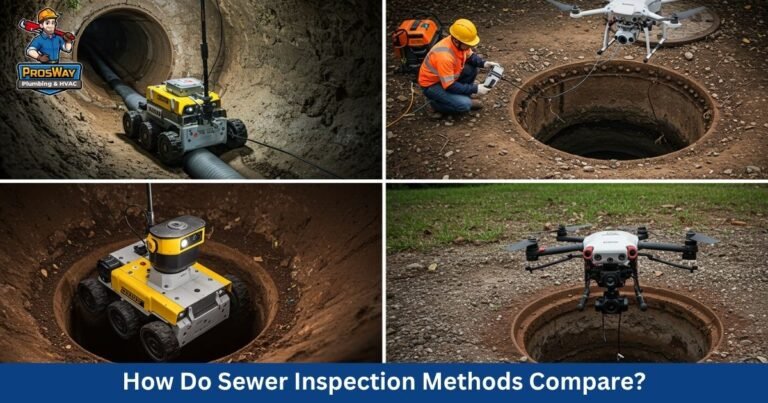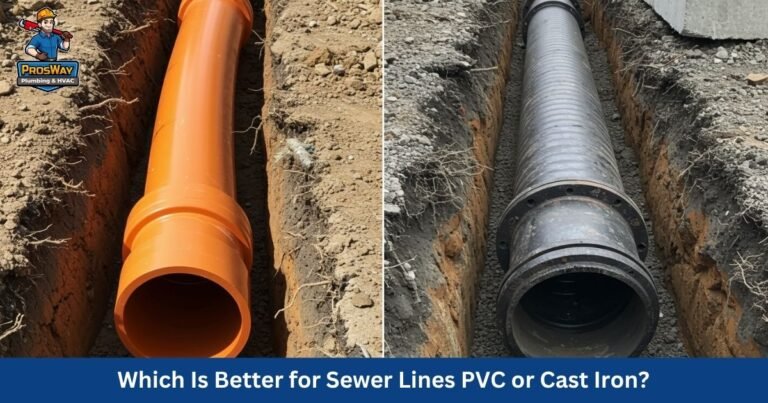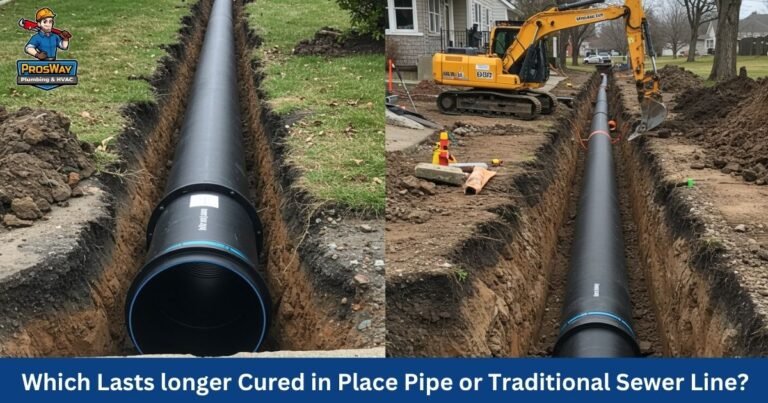When faced with a sewer line problem, homeowners often wonder about the sewer line repair cost breakdown. Several factors, including the damage’s severity and the pipe’s condition.
At ProsWay Plumbing & HVAC, we believe that understanding these variables helps homeowners manage expenses better and avoid surprises.
This article will explore key aspects like repair methods, labor costs, and the impact of pipe location on pricing.
By understanding these elements, readers will gain clarity on the potential sewer line repair cost breakdown, helping them make informed decisions.
What Factors Influence Damage Severity and Pipe Condition?

Initial camera inspection fees play a crucial role in diagnosing sewer line issues effectively. It is important to differentiate between minor leaks and major breaks.
The type of pipe material used also affects the necessary repair methods, while the age of the pipe contributes to the complexity of the repair.
Additionally, assessing the extent of root intrusion can significantly impact repair costs, especially in relation to soil conditions.
Initial Camera Inspection Fees for Diagnosis
Initial camera inspection fees can vary based on several factors, but they are vital for accurately diagnosing sewer line issues.
On average, these fees range from $400 to $500, depending on the complexity of the landscape and the accessibility of the pipes.
An inspection allows professionals to identify issues such as pipe breaks or blockages before any costly repairs are initiated.
By leveraging advanced camera technology, plumbing experts can assess the condition of pipes under concrete slabs without invasive methods. This proactive approach saves time and reduces overall repair costs associated with potential pest control.
How Can You Identify Minor Leaks Versus Major Breaks?
Identifying whether a sewer line problem is due to minor leaks or major breaks is essential for determining repair costs and strategies.
For instance, a clogged sewer line might indicate small leaks in polyvinyl chloride (PVC) piping, which can often be resolved with trenchless sewer methods.
Conversely, significant breaks in cast iron pipes can lead to extensive damage, necessitating more costly and invasive repairs.
Homeowners should be aware that minor leaks typically result in slight changes in water pressure or slow drainage, while major breaks often manifest as substantial water accumulation.
Those experiencing frequent backups or unusual smells should consult plumbing professionals who can conduct thorough inspections to determine the severity of the issue.
How Does Pipe Material Impact Sewer Line Repair Costs?
The type of pipe material significantly influences the costs and methods involved in sewer line repairs. For example, cast iron pipes, commonly found in older homes, are prone to corrosion over time, leading to more complicated repairs.
In contrast, modern PVC materials are more durable and easier to repair, often allowing for quicker trenchless methods.
How Do Traditional Excavation and Trenchless Repair Methods Affect Sewer Line Costs?
Sewer line repair cost breakdown varies significantly between traditional excavation and trenchless methods. Digging to access sewer lines often leads to higher expenses due to labor and restoration needs, while pipe lining solutions provide a potentially more affordable alternative.
Price considerations for pipe bursting techniques also play a role, as choosing the appropriate method based on property layout influences overall costs.
Understanding trenchless repair expenses in comparison to traditional digging prices helps homeowners make informed decisions regarding their sewer line replacement.
Cost Factors of Digging Trenches for Sewer Line Access
Digging trenches for sewer line access can lead to significant costs due to various factors, including labor, equipment rental, and restoration needs.
When a technician digs to address sewer line issues, they must often navigate obstructions like water heating systems, landscaping, or other features of the property.
Additionally, the specific zip code can influence labor rates and material costs, further impacting the total expense of the repair.
Once digging is complete, the work doesn’t end there. Restoring the surface and any landscaping affected by the excavation adds to the total bill.
Homeowners must also consider how their insurance policy addresses such repairs; sometimes, coverage can mitigate costs related to sewage problems.
Why Consider the Financial Benefits of Pipe Lining Solutions?
The financial aspects of pipe lining solutions can vary based on several factors, including the length and condition of the existing sewer line.
Homeowners often find that rehabilitation using plastic liners is more affordable compared to traditional excavation.
This method minimizes additional expenses related to surface restoration after repairs are completed. Moreover, the odor associated with sewer line issues can lead to urgent treatment needs.
You can watch this video, The trenchless pipelining process explained.
When utilizing trenchless technology for pipe lining, homeowners typically experience lower overall costs, as this process requires less labor and time than digging.
By opting for this effective repair solution, property owners can address sewer line problems quickly while keeping expenses in check and avoiding extensive property damage.
What Should You Know About the Price of Pipe Bursting Techniques?
Price considerations for pipe bursting techniques often stem from the length and condition of the existing sewer line. This trenchless technology allows for the replacement of old pipes, such as clay sewer lines, without extensive digging, reducing both labor and restoration costs.
Homeowners can benefit from using a sewer line camera to evaluate their current pipe condition, ensuring that the investment in pipe bursting addresses the actual needs.
While trenchless sewer line methods may involve a higher initial outlay than traditional excavation, they often result in lower overall expenses.
For those with septic tanks or older clay pipes, opting for pipe bursting can prevent costly repairs associated with extensive surface restoration.
What Should Homeowners Know About Labor Expenses and Professional Fees for Sewer Repairs?
The sewer line repair cost breakdown is influenced by several key factors, including the hourly rates for plumbers and specialized technicians.
Geographic location plays a significant role in determining labor costs, and emergency service call fees can increase the total for urgent sewer line issues.
Each of these elements will be explored in detail, providing homeowners with a clear understanding of what to expect during sewer line repairs.
What Are the Hourly Rates for Plumbers and Specialized Technicians?
The hourly rates for plumbers and specialized technicians can vary significantly based on location and the complexity of the sewer line repairs needed.
On average, homeowners may expect to pay between $400 to $450 per hour, with some plumbing services charging more for emergency calls or specialized expertise.
Knowing this helps homeowners budget for unexpected expenses, especially when repairs are covered under home insurance, which may help offset some costs.
For instance, a drain cleaner might charge less for straightforward tasks compared to the rates applied to extensive sewer line repairs that require advanced equipment.
Understanding these differences empowers homeowners to make informed decisions when seeking plumbing services.
Charges for Specialized Equipment Usage During Repair
Charges for specialized equipment usage during sewer pipe repair can significantly impact the overall cost for homeowners.
Professional plumbing services often require advanced tools, such as trenchless technology or camera inspection systems.
These tools enable quick assessments and repairs, ultimately reducing the time and labor needed for construction-related tasks.
For instance, using specialized equipment can streamline the repair of damaged sewer pipes, minimizing the disruptive excavation process associated with traditional methods.
Homeowners can expect that the investment in quality equipment results in lasting repairs, providing peace of mind.
Why Does Geographic Location Influence Sewer Repair Labor Costs?
Geographic location plays a significant role in determining the labor costs for sewer line repairs. Areas with higher living costs often see increased hourly rates for plumbers.
Emergency services typically incur additional fees, especially in urban settings, where quick response times are crucial.
For example, areas prone to mold growth due to moisture from sewer problems may require more specialized expertise for repairs.
The presence of older infrastructure, such as outdated valves, can also affect the complexity and, consequently, the cost of sewer line repair services.
What Should Homeowners Know About Material Expenses and Permit Requirements for Sewer Repairs?

Material expenses and permit requirements substantially influence the overall cost of sewer line repair. The price points for different sewer pipe materials, such as PVC or cast iron, vary significantly.
Additionally, the expense of necessary fittings, connectors, and sealants can add up, along with any municipal permits and fees required.
Homeowners should also account for code compliance upgrades that may impact material choices, as well as the length of pipe needing replacement or repair.
What Are the Price Points for Different Sewer Pipe Materials?
The cost of sewer line repairs can vary significantly depending on the type of pipe material used.
For instance, PVC pipes are generally more affordable than older materials like cast iron, which can be prone to corrosion and require more expensive repairs.
Homeowners should weigh the upfront costs of materials against their durability and the potential long-term expenses associated with maintenance and repairs.
In addition to material costs, local building codes may necessitate permits, which can add to the overall expense of sewer line projects.
While permits might involve additional fees, they ensure that installations meet safety and regulatory standards.
These requirements allow homeowners to budget effectively and make informed decisions about the materials best suited for their sewer line repairs.
Expense of Fittings, Connectors, and Sealants Used
The expense of fittings, connectors, and sealants plays a vital role in the overall cost of sewer line repair.
These essential components are necessary for joining different sections of pipes securely, ensuring there are no leaks.
Homeowners should understand that the quality of these materials can affect both the reliability of the repair and the long-term maintenance costs.
How Do Permit Requirements and Associated Fees Impact Costs?
Obtaining necessary municipal permits is a vital step in the sewer line repair process. Each locality has specific regulations regarding plumbing work.
Homeowners should consult with their plumbing professionals to identify the required permits and understand their associated fees, as these costs can vary widely by region.
These inspections are essential for ensuring that all work meets applicable building codes and safety standards.
By investing time and resources into obtaining the correct permits upfront, homeowners can prevent complications and extra expenses.
That arises from not following local regulations, ultimately ensuring a smoother and more efficient repair process.
What Restoration Costs and Added Expenses Should You Expect After Sewer Line Repair?

Homeowners should factor in several potential expenses when budgeting for sewer line repairs. This includes costs for landscape restoration and fixing driveways or walkways disturbed during excavation.
Additionally, unexpected issues may arise during the repair process that require interior plumbing adjustments.
Cleanup and site restoration charges can also impact the overall repair budget, making careful financial planning essential.
Budgeting for Landscape Repair After Excavation Work
Homeowners should be prepared for landscape repair costs that may arise following sewer line excavation work.
Disturbances to lawns, gardens, or hardscaping can lead to unforeseen expenses as these areas require restoration to return to their original state.
The potential for additional costs helps in budgeting effectively for sewer line repairs, ensuring that not only the plumbing issue is addressed.
To minimize landscape repair expenses, homeowners may consider planning for restoration options in advance.
This can include reseeding grass, replanting flowers, or replacing damaged pavers, which can add to the overall budget.
Engaging with landscaping professionals to assess damage before repairs can provide valuable insights, helping owners allocate funds appropriately.
What Are the Costs to Fix Driveways or Walkways After Sewer Repairs?
After sewer line repairs, homeowners often face costs to fix driveways or walkways that may have been disturbed during the excavation process.
These repairs can vary significantly depending on the extent of damage and the materials used. For instance, replacing concrete may involve pouring new slabs, while restoring pavers requires resetting each piece individually.
In many cases, the total cost for fixing driveways or walkways includes labor and material expenses that can quickly accumulate.
Homeowners should consider engaging professionals who can provide estimates before work begins, ensuring that they factor these costs into their budgets.
By planning for potential restoration needs, property owners can better navigate the financial aspects of sewer line repairs and maintain the aesthetic appeal of their outdoor spaces.
How Do Cleanup and Site Restoration Charges Impact Final Costs?
Cleanup and site restoration charges are crucial factors that homeowners need to consider when planning sewer line repairs.
After excavation and repair work is completed, it is common for surfaces such as lawns, driveways, and walkways to require significant restoration.
The costs associated with repairing these areas can vary based on the extent of the disruption and the materials involved, making it important for homeowners to understand.
For instance, if landscaping has been disturbed, homeowners may need to replant sod or replace shrubs, which can add to the total costs.
Additionally, restoring concrete surfaces or pavers often involves specialized labor, as each piece may need careful resetting or replacement.
Planning for these cleanup and restoration charges allows homeowners to have a clear picture of their financial obligations.
Conclusion
The sewer line repair cost breakdown is crucial for homeowners facing plumbing issues. Factors such as pipe material, age, and accessibility all significantly impact repair expenses. By recognizing these elements, property owners can make informed decisions, prioritize repairs, and potentially mitigate costs. Proactive planning and regular inspections are essential to prevent major expenses, ensure a reliable plumbing system, and protect the investment in their homes.
Ready to Repair Your Sewer Line the Right Way? Call ProsWay
Facing sewer line problems? ProsWay Plumbing & HVAC offers transparent pricing, expert service, and complete restoration solutions — no hidden fees, no stress. Call us now at (862) 260-5870 or Book Online for residential clients in Parsippany and neighboring areas of North Jersey.









